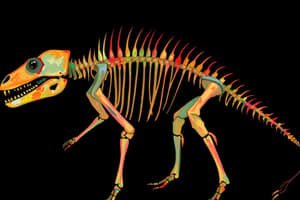Podcast
Questions and Answers
Where is the nerve cord situated in chordates?
Where is the nerve cord situated in chordates?
- Dorsally (correct)
- Ventrally
- In the presence of ganglia
- Absent in chordates
What is the main characteristic feature of chordates?
What is the main characteristic feature of chordates?
- Absence of a nerve cord
- Presence of a dorsal notochord (correct)
- Presence of a ventral notochord
- Lack of pharyngeal pouches
Which direction does the blood circulation run in chordates?
Which direction does the blood circulation run in chordates?
- Anterior to posterior ventrally and from anterior to posterior dorsally
- Posterior to anterior ventrally and from posterior to anterior dorsally
- Posterior to anterior ventrally and from anterior to posterior dorsally (correct)
- Anterior to posterior ventrally and from posterior to anterior dorsally
What is the special body region situated posterior to the anus in chordates?
What is the special body region situated posterior to the anus in chordates?
What do chordates share with non-chordates as common features?
What do chordates share with non-chordates as common features?
Flashcards are hidden until you start studying
Study Notes
Chordate Characteristics
- In chordates, the nerve cord is situated dorsally, above the notochord, and runs along the length of the body.
- The main characteristic feature of chordates is the presence of a notochord, a dorsal hollow nerve cord, pharyngeal slits, and a post-anal tail.
- In chordates, the blood circulation runs in a double circulation pattern, where oxygenated blood from the heart runs anteriorly and deoxygenated blood runs posteriorly.
- The special body region situated posterior to the anus in chordates is the post-anal tail.
- Chordates share with non-chordates the common features of bilaterally symmetrical body, segmental organization, and coelom.
Studying That Suits You
Use AI to generate personalized quizzes and flashcards to suit your learning preferences.




